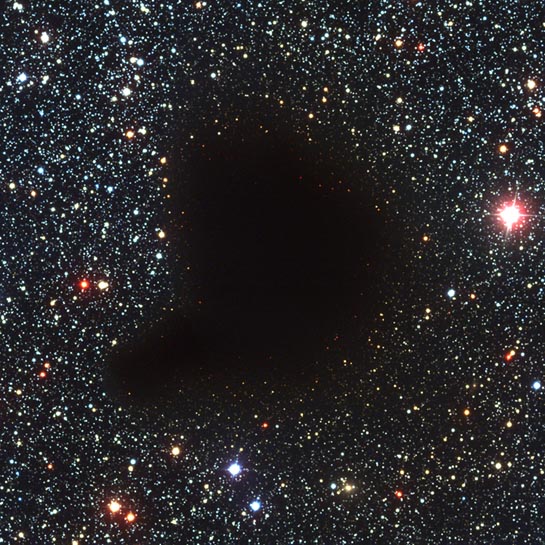
Dark nebula, Bok Globule
RA 17h 22m 38.23s Dec -23° 49' 34.69"
Ophiuchus
500 light years
6.53 x 6.52 arcminutes
North is 0.1° right of vertical
ESO
April 30, 1999
ABOUT THIS IMAGE:
This photograph shows an unusual sky field in the Milky Way band. It is centered on one of the classical, dark globules, known as Barnard 68 (B68) after the American astronomer, Edward E. Barnard (1857 - 1923), who included it in a list of such objects, published in 1919. It appears as a compact, opaque and rather sharply defined object against a rich, background star field. Even on this image that registers many faint stars in the area, not a single foreground star is observed. This is a clear sign that this globule must be relatively nearby.
Interstellar clouds consist of gas and dust, including many molecules, some of which contain carbon atoms (i.e. organic). For a long time considered to be "holes in the sky", molecular clouds are now known to be among the coolest objects in the Universe (the temperature is approx. 10 K, or -263 °C). Moreover, and most importantly, they are nurseries of stars and planets.
It still remains a mystery how a dark cloud like Barnard 68 at some moment begins to contract and subsequently transforms itself into hydrogen-burning stars. However, deep images of these clouds, such as this one obtained by FORS1 on VLT ANTU, may provide important clues. This small cloud seems to be in its very earliest phase of collapse. It has a diameter of only 7 light-months (approx. 0.2 pc) and it is located at a distance of about 500 light-years (160 pc) towards the southern constellation Ophiuchus (The Serpent-holder).
This
three-color composite was reproduced from one blue (B), one green-yellow
(V) and one near-infrared (I) exposure that were obtained with VLT ANTU
and FORS1 in the early morning of March 27, 1999. The field measures 6.8
x 6.8 arcmin. North is up and East is to the left.